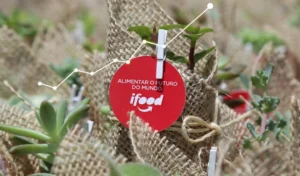A healthy diet is one of the pillars of sustainable eating. But for about 3.1 billion people Around the world, it was impossible to afford a healthy diet in 2020, according to the UN.
This alarming global scenario makes talking about this issue increasingly urgent and necessary. Furthermore, it is necessary to act at all stages of food production, distribution and consumption.
This is because only with harmony between agricultural production and environmental Conservation, healthy habits and reducing food waste sustainable food can be achieved.
In this guide you will find everything about sustainable eating, its benefits and the role of companies (including technology) so that it becomes a reality for more people.
What is sustainable eating?
Sustainable food is one whose food is accessible to everyone, in quantity and quality, nutritionally adequate, locally produced and little processed.
According to the FAO (Food and Agriculture Organization of the United Nations), it must have low environmental impact and protect biodiversity.
Furthermore, it needs to be culturally acceptable and accessible and economically fair. In addition to optimizing natural and human resources.
What is its importance?
The importance of sustainable food lies in the fact that the modern food system has caused a negative social, environmental and economic impact on the planet.
Contemporary large-scale food production demands energy, water and large areas of land, which has caused damage to the environment and ecosystems.
The problems caused by the current food production system are the loss of biodiversity, pollution, global warming and groundwater contamination.
Therefore, a socially fair and nutritionally rich sustainable diet is important to protect biodiversity and ensure security for present and future generations.
Benefits for you to know
The benefits of this type of food are countless, both for the general population, cultures and society, as well as for the planet's biodiversity and ecosystems.
As it is based on low-processing food production systems, organic, seasonal and diversified, sustainable food is superior to non-sustainable food.
The quality of food in the sustainable food production chain is, therefore, higher than that of ultra-processed foods, which may have little diversity and nutrients.
Healthy and sustainable eating: understand the differences
The difference between healthy eating and sustainable eating is that the first covers the quality of the food, while the second covers all production.
Despite this difference, healthy eating and sustainable eating are intrinsically linked. After all, a food system that is not environmentally, socially, culturally and economically sustainable cannot produce healthy food.
Sustainable eating consists, among several practices, of offering healthy, nutritionally rich, varied, seasonal foods without chemical additives and preservatives.
What is the role of companies?
The role of companies and startups in sustainable food is to ensure greater sustainability in production as a whole and expand the supply of healthy foods.
How to sustainably feed a global population that is expected to reach 9.7 billion of people in 2050 is a challenge that companies and startups are already facing.
Some actions must be taken so that this role is fulfilled by companies and startups to offer food products that contribute to everyone's health.
Second article of Gepea (Junior Company of the Faculty of Food Engineering at Unicamp), some of these actions are:
- Product reformulations following current standards, such as sodium reduction It is trans fat;
- Correct disposal of industrial waste;
- Investment in the use of sustainable packaging;
- Optimization of sustainable production processes;
- Investment in water reuse;
- Recycling of trash.
How technology companies can contribute
To the foodtechs (food technology companies) can contribute to sustainable food through the use of technology in the development and offering of innovative and sustainable food products.
Ats foodtechs, technology is used throughout the production process, be it a delivery and logistics company, for example, or a Superfood, which creates new food alternatives.
The market for foodtechs is on the rise. So much so that one lifting unprecedented showed that foodtechs received more than US$ 1 billion in investments between 2010 and 2021 in Brazil.
10 tips for having a sustainable diet
There are several ways to have a sustainable and healthy diet, which combines environmental preservation with care for our health.
O Food Guide for the Brazilian population, for example, provides guidance for those who want to know how to have a healthy diet on a daily basis, with affordable products.
The document Sustainable Food: Sustentarea Manifesto presents sustainability actions that are related to food.
Do you want to know what the main guidelines are on this? See below 10 tips for having a sustainable diet.
- Practice diversity in your diet and consume a variety of foods, especially in nature or minimally processed;
- Seek a balance between your food intake and daily energy needs;
- Consume minimally processed foods, such as tubers, whole grains, fruits and vegetables, especially those less prone to spoilage;
- Reduce meat consumption, especially beef;
- Avoid foods rich in fat, salt and sugar and those poor in micronutrients and ultra-processed foods;
- Read food labels and pay attention to the list of ingredients;
- Give preference to organic and locally produced foods;
- Prefer companies in the food sector and foodtechs aligned with sustainability;
- Use biodegradable packaging, such as paper, cardboard and bioplastic and avoid foods with excess packaging;
- Avoid food waste at home and in commercial establishments.
Examples of sustainable eating
Examples of sustainable eating are products, companies, initiatives and projects that focus on the sustainability and healthiness of food.
With regard to products, examples are: superfoods, such as plant-based foods (made from plants), which are alternatives to animal protein, as well as plant-based milks.
Food products clean label, produced with fewer chemical additives or using more natural raw materials and functional foods and beverages are other examples.
The movement Farm to Table (From field to table), which brings the producer closer to the consumer, is an example of a sustainable solution that reduces intermediaries and increases the effectiveness of the supply chain.


